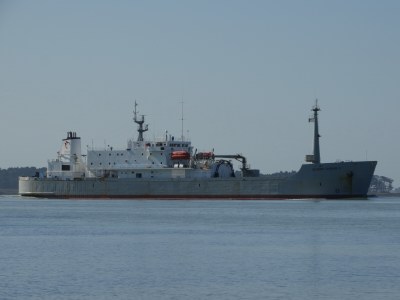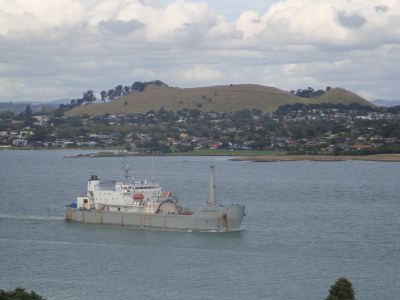The Ultimate New Zealand Soccer Website | home
La Bonita | Lali | Lorena | Luhesand | Maasmond | Mamaku | Manawanui | Maranui | Matipo | Maunganui | Melva | Milburn Carrier | Milburn Carrier II | Mirabella | Moana II | Moanui | Moanui | Moresby Chief | Nanok S | Ngamaru II | Ngamaru III | Nikau | Niugini Kula | Niuvakai | Norfolk Trader | Northern Transporter | Onehunga | Onehunga | Oriental Surveyor | Other Vessels Of Note
Milburn Carrier II
 |
||||||||||||||||||||
Built in Ulsan, she is powered by one 5609hp Hyundai diesel, producing a service speed of 14 knots.
She was launched on 20 May 1987, and completed five months later, but remained in Ulsan for four months while a dispute about her manning levels took place.
NZ Cement Holdings wanted to employ 13 crew on board, because of the high degree of automation on board, but the Merchant Service Guild (representing ship deck officers) had 18 crew as their target figure.
While the dispute continued, "MC2" made her way to New Zealand, arriving in Westport on 15 March 1988. It took a further four months before the matter was settled, and she finally went to work in mid-July 1988, nine months after being handed over to her owners.
 Two years later, she became the latest ship to "berth" alongside Mangere Bridge! At 0915 on July 9, 1990, she was casting off from the wharf when a mooring rope got caught in the propellers, jamming the bow thruster.
A combination of wind and tide pushed her starboard side on to the bridge, denting the railing. A bolt on the bridge punched a 16mm hole in her freshwater tank, while the tug "Manukau" narrowly escaped being caught between the ship and the bridge - damage to her paintwork was proof of her close call.
The bridge was closed to human traffic while she was alongside over the next couple of hours, and she eventually returned to her berth, allowing divers to clear the rope and repairs to the freshwater tank to be carried out. She sailed next day at 1000.
In October 1990, "MC2" sailed into the history books as the first integrated ship in the New Zealand merchant fleet. An integrated ship is one carrying multi-taking seafarers, and eliminates the previous divisions which existed between deck and engineering crews.
But back to when she arrived ... well, as you can see from the below pic, no prizes for guessing why I nicknamed her "Stumpy"! Call that a mast?
 It was replaced in January 1994 by the mast-and-crane unit which had graced "Union Nelson" and "Capricornia", until that ship capsized at the wharf in Suva in October 1991. The Liebherr crane of that mast was removed from "MC2" in mid-2012, but it had certainly served its purpose in between times.
In February 1994, NZ Rail, under the guise of their Railfreight brand, launched the "Coastliner" container service between Onehunga, Nelson and Westport, chartering space on the "MC2", the deck of which was modified to carry 24 containers, including ten integral power points, all of which were loaded aboard via the aforementioned crane.
On 29 September, 1994, "Milburn Carrier II" arrived at Onehunga with its biggest load of containers - 22 - since it was modified to carry them. Eighteen of the units, each containing 15.7 tonnes of milk powder, were later shipped to Peru, part of the NZ Dairy Board's annual 10,000 tonne shipment for use in the making of condensed milk.
A similar sort of deal was established following multi-party talks involving, amongst others, Dynochem NZ, a resin manufacturer in New Plymouth, and Nelson Pine Industries, whereby "MC2" would call at the Taranaki port on her way south, load up to 400 tonnes of resin carried in dedicated bulk tanks fitted on board, and discharge it at Nelson en route back to Westport for another load of cement.
This service began in July 1993, and together with the "Coastliner" arrangement, meant the ship's utilisation improved no end - no longer would return trips from Onehunga to Westport be ballast voyages!
Click the pic for some on-board views of the MC2
In September 2002, "MC2" underwent another change of appearance. It was goodbye to the Milburn funnel markings she had sported since her launch, and hello to the Holcim logo.
At the same time, plans were afoot to rename her "Holderbank Cement" - that's where the Hol in Holcim comes from - but thankfully that didn't happen. ("MC2" rolls off the tongue far more easily, eh?)
Holcim's decision to import cement, rather than produce it at Westport, meant "Milburn Carrier II" primarily operated from Timaru for the foreseeable future. And she was at last able to regularly utilise her full carrying capacity, rather than sail two-thirds full!
Throughout her time on the coast, "MC2" has basically been too big for the port where she's been based, the shallow nature of the Westport bar restricting her loading capacity to around 4000 tonnes of Ultracem (general purpose cement) and 500 tonnes of Rapicem or Duracem (special purpose cements) per voyage.
 It was while berthing in Timaru in February 2017 where "MC2" became an unwilling victim of an out-of-control passenger liner. "Seabourn Encore" broke its moorings in high winds and struck the cement carrier square amidships, holing her ballast tank and sidelining her for six weeks while repairs were undertaken - during this time, Holcim cement had to be distributed by truck, as "MC2"'s successor, "Buffalo", was still being readied for service around NZ's shores.
In the last two weeks of April 2018, "Milburn Carrier II" embarked upon a final tour of duty around all the ports she had regularly served since Holcim relocated their South Island distribution base to Timaru.
Lyttelton, Nelson, Wellington, Napier and Dunedin - fittingly the final port at which she discharged, given Milburn Cement was founded in Otago some 130 years ago in 1888 - were visited for one final time by the ship, before she returned to Lyttelton for changes of flag and name as her thirty-year career carrying cement around the country drew to a close.
She deaprted for Wellington on May 4 under the name "NACC Milburn", the ship having been acquired by Nova Algoma Cement Carriers Ltd., a joint venture between Canadian-based Algoma Central Corporation and Swiss-based Nova Marine Carriers. Two days later, the biggest ship to call at Onehunga sailed for Singapore, leaving New Zealand waters behind forever.
She now trades out of Salalah, in Oman, to the ports of Duqm and Sohar, both also in Oman, and Al Mukalla and Aden, both in Yemen.
|

Coming through the Heads - sourced from Ships of NZ Facebook page
